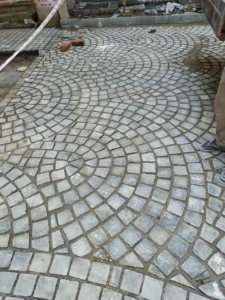What is Cobblestone Flooring?
Cobblestone, reminiscent of old-world streets in Europe or quaint little towns, has its roots deep in history and remains one of the most charming choices for outdoor flooring. When we walk on the streets of cities like Rome or Prague, the cobbled paths beneath our feet echo tales from the past. Today, many homeowners and designers are bringing this age-old charm to contemporary settings with cobblestone flooring.
Origins of Cobblestone
The term “cobblestone” derives from the English word “cob”, which means a rounded lump. Traditionally, cobblestones were naturally rounded stones that were collected from stream beds. They were used for centuries to pave roads because of their naturally rounded and smooth finish. The roads made of these stones were known as ‘cobbled streets’.
Characteristics of Cobblestone
Durability: Cobblestones are known for their durability and strength. They can withstand heavy traffic, be it from pedestrians or vehicles, making them ideal for driveways or high-footfall areas.
Aesthetics: Cobblestones are often admired for their old-world charm. They come in various colors, usually grey, black, brown, and sometimes even reddish tones, depending on the type of stone used. Their irregular sizes and shapes contribute to their rustic look.
Maintenance: While cobblestone pathways or floors might require occasional maintenance like resetting or filling gaps, they last for generations if laid correctly.
Natural Traction: Due to their uneven surface, cobblestones provide natural traction, reducing the chances of slipping, especially when wet.
Cobblestone Flooring in Modern Times
While traditionally used for outdoor roads and pathways, the versatility of cobblestone flooring has been rediscovered by contemporary architects and interior designers.
Driveways and Patios: Cobblestone driveways are not only durable and able to withstand the weight of vehicles, but they also add an elegant, timeless look to any property. Similarly, patios with cobblestone flooring can become the perfect backdrop for garden parties and outdoor events.
Interiors: While less common, cobblestone can be integrated into interior design. They’re often seen in rustic-themed homes, especially near fireplaces or in wine cellars to accentuate the vintage vibe.
Commercial Spaces: For businesses that want to create a distinctive look or evoke a sense of history, cobblestones are an excellent choice. They’re often used in the hospitality industry, in hotels, cafes, or restaurants with historical themes.
Installation and Maintenance
Installing cobblestone flooring requires expertise. Proper foundation, placement, and finishing are essential to ensure the flooring lasts for years.
Foundation: It’s crucial to have a well-prepared foundation, usually a compacted base of gravel or sand. This ensures proper drainage and prevents the cobblestones from shifting.
Placement: The stones are then laid closely, and the gaps between them are filled with sand or another binding material. This binding material can be sealed for added longevity.
Maintenance: Over time, some cobblestones might become loose. It’s essential to check them periodically and re-set any that are unstable. Cleaning cobblestone flooring is relatively easy. A gentle power wash can remove most grime and debris.
In Conclusion
Cobblestone flooring offers a blend of durability and aesthetic appeal that few other materials can match. Whether you’re looking to recreate a historic feel, add a rustic touch, or just want a reliable and beautiful flooring solution for your outdoor spaces, cobblestones are worth considering. Like the stories of the ancient streets they once paved, cobblestones stand the test of time, both in durability and timeless charm.


